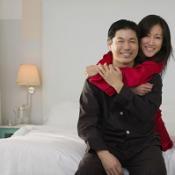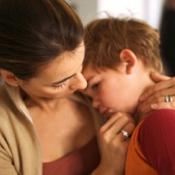 We all share a basic human need for a response: to be seen, to matter, to be loved. None of us can escape the question, if I am in need, will someone be there? In order to receive we need to ask; in order to give we need to engage. Either position can feel tremendously risky when we are unsure of how, or if, the other will respond. When fear, despair, shame, or any strong emotion blocks us from reaching and responding, how then do we get our needs met?
We all share a basic human need for a response: to be seen, to matter, to be loved. None of us can escape the question, if I am in need, will someone be there? In order to receive we need to ask; in order to give we need to engage. Either position can feel tremendously risky when we are unsure of how, or if, the other will respond. When fear, despair, shame, or any strong emotion blocks us from reaching and responding, how then do we get our needs met?
Couples in pain have much to risk and much to lose by taking a giant leap of faith and entering relationship therapy. We know that couples in distress often wait years before seeking help. These couples endure a slow, daily dance of increasing dissatisfaction and distress. Conversely, there are couples who come into therapy in crisis, thinking everything was fine until the discovery of something injurious, such as an affair or a declaration of, “I am just not in love with you anymore.” These partners are shell shocked and blindsided. As therapists, how do we help a couple in pain begin to heal?
Healing a troubled relationship is a tall order for any therapist, no matter how skilled he or she is. But what if, instead of trying to heal the past relationship, we help the couple create a new relationship that heals? What alternatives do we have for prescribing communication strategies, “I” statements, date nights, division of labor contracts, and wish lists? What would it look like, if we, as therapists, could bring people into their emotions through moment-to-moment processing of their feelings for and with each other? This would be far more productive than getting sucked into the he said / she said complaints that most couples are ready to recite from unending, impenetrable ledger lists. What would it look like to help create safety for those couples, and simultaneously dig down beneath all the words they wish they never said, all the deeds they would erase if it were possible, and help them to reach for their partner in a softer, more authentic way?
It would look like Emotionally Focused Therapy (EFT).
The Attachment Lens and EFT
Emotionally Focused Therapy sees the client, couple, or family through one lens: attachment. The associated attachment theory was developed by John Bowlby, who attempted to understand the intense distress and coping behaviors (crying and searching) in infants when separated from the person they had come to rely on for support, responsiveness, protection, and care. That person was the primary attachment figure.
Bowlby argued that through the process of evolution, these attachment needs and behaviors became wired in all humans. Infants able to stay proximate to their protector had a better chance of surviving to adulthood, thus natural selection gave rise to an attachment behavioral system that regulated connection and proximity to the caregiver or attachment figure.
Later, Hazan & Shaver (1987) began to explore the possibility that the attachment processes and motivational behavior systems in infants might actually have relevance and pay out similarly in adult romantic love. They observed numerous common characteristics between infants and caregivers to adult romantic partners, including:
- Each feels safe when the other is nearby and responsive
- Both engage in close, intimate, bodily contact
- Each feels insecure when the other is inaccessible
- Both share discoveries with one another
- Both play with one another’s facial features and exhibit a mutual fascination and preoccupation with one another
- Both engage in “baby talk” (Fraley, 2010)
Hazan and Shaver moved romantic love and adult relationships into a whole new place where partners can be, and are, significant attachment figures. Experiencing one’s partner as a significant attachment figure can be extraordinarily powerful in deepening relational bonds, strengthening intimacy and promoting responsiveness and trust. This is especially true if both partners have experienced and developed a secure attachment style.
However, much can happen when couples misunderstand and misdirect their imbedded attachment responses with each other. What happens when the answer to questions like, “Are you here for me?” “Do I matter?” or “If I call will you come?” feels like “NO”? Couples in this place can feel rejected, hopeless, isolated, mistrustful, angry, frustrated, indifferent, withdrawn, worthless, trapped… the list of painful states is endless.
Within the EFT Attachment frame, Dr. Sue Johnson, co-creator of EFT for couples, simplifies adult attachment within a “finite set of predictable attachment strategies” observed in couples in distress (Johnson, 2004), as follows:
Anxious: The anxiously attached partner may be characterized as an “angry pursuer,” criticizing, yelling, or following a partner out of the room in a “we are not done yet!” attitude. He or she may be known to state something like, “You never talk to me, everyone is more important to you than I am!”
What is really happening? From the position that behaviors always make sense through an attachment lens, perhaps this person is not simply fighting, but fighting for connection, for a response and a way back to some sense of closeness and safety.
Avoidant: A partner who has an avoidant attachment style tends to think or say things like, “I will get away from this; I will placate and give in; I will become dumb and care less.” This person often gets a negative reputation. His or her partner may think, “If only he/she would just talk to me!” Again, if we put on an attachment lens, there is another way to see this.
The pattern of disengaging, while it can be the worst thing possible for the anxiously attached partner, can also be a way of protecting the relationship. By taking a break, partners can skip over some pain and get back to a place of calm, even if that calm means distance.
Fearful: This attachment style is best described as chaotic. It embodies both “I want you to come close” and “I want you to get away.” If a person has a fearful attachment style (which includes anxious, avoidant/ anxious, and ambivalent) this chaos and disorganization makes sense to him or her, but not to a partner.
The partner with a fearful style of attachment expresses an intense desire to be close, but if his or her experience in the current relationship (and possibly in past relationships or family of origin) is fraught with abandonment, this person may be trying to convey, “I want for you to be close to me, but you (and/or everyone else important to me) have gone away so many times, and I have been in so much pain because of that. And now, even when you come close, I cannot tolerate the fear and mistrust that you will go away, withhold your love, or reject me. So I end up doing things to push you away.”
When couples are in distress, the underlying need and emotion driving this chaotic behavior is generally outside awareness. Therefore, this cycle of push-and-pull continues, as do conflict and escalation.
Secure Attachment: Individuals with secure attachment tend to have a greater level of comfort with commitment, dependency, and intimacy; have an easier time communicating about relationship issues and challenges; and share feelings and seek out support.
Secure attachment is the ideal end goal of EFT. Certainly, there is much more to be learned about attachment—both childhood and adult, brain response to relational stress and repair, neuroscience, and the nuts and bolts of the evolution of the mammalian brain in connection to others. For those who wish to read more about the science of love, there are resources listed on my web site.
For the purpose of this series, though, what I hope you come away with is a curiosity and desire to explore this “lens” of attachment and how it can create a different view: one where we can begin to organize and make sense of the complexities of human need for connection and love, with compassion and resonance.
If we, as therapists, partners, parents, colleagues, family members, and friends bring an attachment focus to our relationships, what might happen? How does creating space, grace, and safety create the possibility for transformation and change? If we begin to contemplate that hurtful behaviors experienced from our loved ones who matter most, may in fact come from a deeply wired longing for connection to us—rather than a deficit, or an intentional decision to give us pain—how would that change those relationships? How might a new attachment view change us? What if we could harness the power of attachment and use it to create new, corrective emotional experiences that get under our defenses, beyond the content of dissatisfaction and the behaviors of conflict, and go straight for the heart?
This is what EFT aims to do, by creating experiences that transform relationships and give rise to opportunities for healing and safety.
Resources:
- Johnson, S.M. (1996) (2004 -2nd edition). Creating Connection: The Practice of Emotionally Focused Marital Therapy. New York: Brunner/Mazel.
- Hazan, C. & Shaver, P. (1987) Romantic Love conceptualized as an attachment process. Journal of Personality and Social Psychology, 52(3), 511-524.
- Fraley, R. C., & Marks, M. J. (2010). Westermarck, Freud, and the incest taboo: Does familial resemblance activate sexual attraction? Personality and Social Psychology Bulletin, 36, 1202-1212.
© Copyright 2013 GoodTherapy.org. All rights reserved.
The preceding article was solely written by the author named above. Any views and opinions expressed are not necessarily shared by GoodTherapy.org. Questions or concerns about the preceding article can be directed to the author or posted as a comment below.

 Three Intimacy-Enriching Lessons Every Person Deserves
Three Intimacy-Enriching Lessons Every Person Deserves Five Domains of a Healthy Relationship: Mindfulness and Resilience
Five Domains of a Healthy Relationship: Mindfulness and Resilience The Abused Husband: Dealing with Aggression in Relationships
The Abused Husband: Dealing with Aggression in Relationships